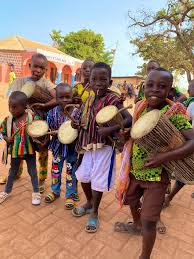The Damba Festival is an exciting event that fills the air with joy and anticipation in Northern Ghana. Every year, communities gather to celebrate their rich heritage. But what truly makes this festival vibrant? What traditions and stories do the dances, prayers, and colourful processions share? As the festival draws near, excitement grows, inviting everyone to join in the festivities and discover the mystery behind its origins.
The festival stands out as a remarkable celebration that captures the essence of northern Ghanaian culture. It blends spirituality, tradition, and community, creating a powerful experience for all who take part.
As we explore this festival, we uncover lively stories and meaningful experiences. These tales encourage everyone to celebrate and appreciate this rich heritage. Through dance, music, and shared moments, the festival leaves a lasting impression on all who participate.
The Origins of Damba Festival
The Damba Festival celebrated in the month of Damba, has a long and rich history. It is observed under the lunar calendar by the people of Dagbon, Mamprugu, Gonja, and also Nanumba. Also, the festival traditionally marks the birthday of the Holy Prophet of Islam. Initially, it emphasised prayers and fasting, creating a spiritual atmosphere for the community. However, as time progressed, the focus shifted.
Today, the festival highlights the significant chieftaincy and also cultural heritage of the Dagbon people. Moreover, the Damba Festival is divided into three main segments: Somo Damba, Naa Damba, and Belkusi Damba. Each segment features its activities and traditions that contribute to the overall excitement.
It begins with the announcement of the month by the Yidan Moli to the Yaa Naa, the king of Dagbon. However, this announcement sets the stage for the celebrations. On the 11th day, the Somo Damba festivities commence, followed by the Naa Damba on the 17th day. Finally, the celebration culminates with Belkusi Damba on the 18th day, marking the climax of the festival.

The transformation of the Damba Festival reflects the community’s desire to celebrate their identity while respecting their roots. The festival has become a vibrant expression of culture, blending historical significance with contemporary values. This evolution invites participants to reconnect with their heritage and share it with future generations.
Features of the Festival
The Damba Festival is characterized by a variety of exciting features that captivate participants and spectators alike. It is organized into three main segments, each offering unique activities contributing to the festival’s overall splendour.
Somo Damba: This segment involves prayers and vibrant dancing. Participants gather to honour their ancestors and seek blessings. The community comes together to celebrate their shared heritage, filling the atmosphere with rhythm and joy.
Naa Damba: This part of the festival is dedicated to the King. It also features impressive dances and horse shows that showcase the community’s pride in their chieftaincy. Participants exhibit their skills in horse riding, creating a dazzling spectacle that highlights the importance of leadership in Dagbon culture.
Belkusi Damba: This segment serves as a colourful farewell procession. It marks the conclusion of the festival, inviting participants to bid farewell to the celebrations in style. The vibrant visuals and joyful spirit reflect the strong sense of community that the Damba Festival embodies.
Throughout the festival, participants also engage in activities like Binchera Damba, where young people wear fashionable smocks, and Shinkaafa Gahimbu, which involves the picking of rice. These events ensure that everyone has something to enjoy as families and friends gather to celebrate.
Significance and Importance of the Festival
The Damba Festival holds immense importance for the people who celebrate it. While it began as a religious observance, it has transformed into a festival that honours the community’s history and values. The primary purpose is to celebrate the rich heritage, history, and chieftaincy of Dagbon and its surrounding kingdoms.
During the festival, families come together to engage in various activities. They visit friends, exchange gifts, and offer prayers to their ancestors. This communal spirit strengthens bonds and reinforces social ties. The festival becomes a time for reflection, gratitude, and unity.
Additionally, the Damba Festival serves as a platform for cultural expression. Participants showcase their customs through traditional dances, music, and attire. The vibrant displays create a sense of pride and identity among community members. As younger generations partake in these activities, they learn about their history and values, ensuring the rich traditions endure.
Ultimately, the Damba Festival fosters a strong sense of belonging among participants. It reminds them of their roots while encouraging them to embrace their cultural heritage. This festival is not just an event; it is a celebration of their identity, history, and unity.
Read Also: 2 Varieties of Drought-Resistant Cowpea Introduced to Northern Farmers